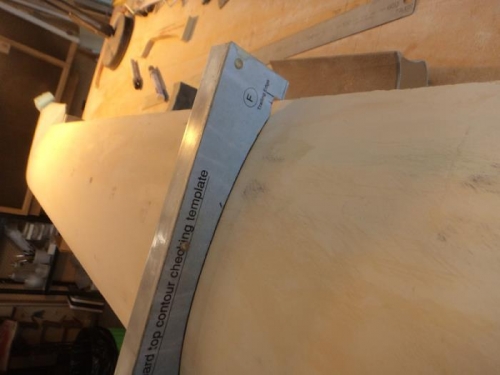| Date: 03-20-2015 | |
| Number of Hours: 20 | |
| Manual Reference: 25-4 |
I’ve been a bit stuck on how to do this step. The method in the previous log entry really didn’t work out for me. I tried a few other things and then put the job off for a while -grin-. I made more templates including one out of aluminium so I could get some marks but dragging it over the curve doesn’t work for me.
Long story short, I’m using my steel templates, the long permagrit block and using a marker pen to find the high spots as you see in pic two. See the dirty marks just forward of the template? I have to be careful to position the template so it matches a line at the leading edge and hooking on the trailing edge. I also have to keep remarking the template edge so I get a bit of ink on the filler surface. After a lot of false starts it seems this method is going to work.
I’m staying a bit shy of the LE so I don’t loose the line and I’ll flip it over and do the bottom before returning to the top the complete this area once the rest of the profile is done. Pic 3 shows I had to add a little more filler in a few divets and low points… which invalidates a lot of work already done. Yeah I’ve done this a few times. I remain committed to do my best work here.
I’ll probably get a good, but not perfect profile sorted out then get the plane off site to mount the wings and canard to the fuselage. Of course with the canard profiling pretty good I should get the incidence correct. Then a post cure of the canard before the final near ‘perfect’ profiling and epoxy wipe stages. Yeah….this will be fun to look back on hahahah.
More filler
Using marks for high spots
More filler



